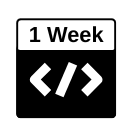DEVELOPER

OVERVIEW
The 3D Tiles for AR Exploration series harnesses the power of Cesium’s 3D Tiles to turn 3D geospatial datasets into immersive, interactive AR experiences. Users can pan and zoom through high-fidelity 3D maps, overlay real-time data, and place virtual objects directly into the physical environment.
PROTOTYPE TYPE
 | Map Interaction | Move and zoom the 3D map tiles, and you can even get navigation or instantly updating AR views or Google Maps. |
 | Location Insights | Overlay real-time traffic, weather, transit lines directly on the 3D map tiles. |
 | AI-Guided Exploration | Activate an AR Agent to narrate points of interest and contextual data as you navigate. |
  | Friend Finder | Locate tagged friends on the 3D map tiles and receive guided directions to their real-world location. |
 | Remote Guidance | Guide someone to a destination in real time, with live map updates reflected in their AR view. |
 | Real Estate Explorer | Instantly explore property listings within the 3D map tiles and preview detailed 3D models or floor plans of each property. |
  | Place Virtual Objects into the Real World | Drop 3D models into the mapped terrain and watch them appear synchronously in AR. |
TECK STACK
Key Technologies | WebXR / ARKit / ARCore |
|---|---|
Front-end | Unity + Vuplex 3D WebView |
Back-end | Real-time Data APIs |
Supporting Tools | Cesium 3D Tiles |
XR Devices | Apple Vision Pro |
Technical Achievements |
|
Add-Ons & Custom Designs |
|
Use Cases |
|
Prototype-to-Delivery Time Estimate |
|

BACKSTORY
Q1: What potential do you think the 3D Tiles has?
A1:
Traditional platforms rely on static 2D maps, forcing users to navigate multiple pages—or even switch apps—to grasp neighborhood context. By embedding 3D Tiles as an AR map paired with the information you need, users can simply tap a location and instantly view its surroundings. This seamless integration transforms location-based browsing into a faster, more immersive, and deeply informative experience.
Q2: What are the advantages of using 3D Tiles for AR exploration?
A2:
Seamless 2D→3D Transition: Instantly switch from a browser map to an immersive AR scene with a single tap or click.
Rich Contextual Insights: Overlay data onto 3D Tiles for deeper spatial understanding—environment density, green space, infrastructure, and more.
Multi-Content Fusion: Combine web UI, multimedia content, AR mapping, and virtual objects into one cohesive experience.
Q3: What limitations should be considered when designing 3D Tiles AR experiences?
A3:
Data Flow Direction: Determine whether the experience requires one-way updates (web → AR) or full bi-directional syncing—necessary for features like live data refresh as users pan the map.
Real-Time vs. Batch Updates: Decide if map data should refresh instantly or can be updated in intervals to reduce load.
Q4: Is there anything that could be improved given more development time?
A4:
Interactive Annotations & Reviews: Enable users to leave comments, star ratings, or recommendations directly on specific locations within the 3D Map Tiles.
Q5: What other scenarios could 3D Tiles for AR Exploration enable in the future?
A5:
When you can freely place any location’s AR 3D map inside your home, I’d use it for travel planning—simulating the entire route from my living room. I could scout which shops sell snacks and drinks, locate restrooms, identify landmarks, gauge road widths, and see if I might need to walk in traffic lanes. This kind of pre-trip rehearsal makes the real journey more comfortable and informed.

DEMO VIDEO
DEVELOPER


OVERVIEW
The 3D Tiles for AR Exploration series harnesses the power of Cesium’s 3D Tiles to turn 3D geospatial datasets into immersive, interactive AR experiences. Users can pan and zoom through high-fidelity 3D maps, overlay real-time data, and place virtual objects directly into the physical environment.
PROTOTYPE TYPE
 | Map Interaction | Move and zoom the 3D map tiles, and you can even get navigation or instantly updating AR views or Google Maps. |
 | Location Insights | Overlay real-time traffic, weather, transit lines directly on the 3D map tiles. |
 | AI-Guided Exploration | Activate an AR Agent to narrate points of interest and contextual data as you navigate. |
  | Friend Finder | Locate tagged friends on the 3D map tiles and receive guided directions to their real-world location. |
 | Remote Guidance | Guide someone to a destination in real time, with live map updates reflected in their AR view. |
 | Real Estate Explorer | Instantly explore property listings within the 3D map tiles and preview detailed 3D models or floor plans of each property. |
  | Place Virtual Objectsinto the Real World | Drop 3D models into the mapped terrain and watch them appear synchronously in AR. |
TECK STACK
Key Technologies | WebXR / ARKit / ARCore |
|---|---|
Front-end | Unity + Vuplex 3D WebView |
Back-end | Real-time Data APIs |
Supporting Tools | Cesium 3D Tiles |
XR Devices | Apple Vision Pro |
Technical Achievements |
|
Add-Ons & Custom Designs |
|
Use Cases |
|
Prototype-to-Delivery Time Estimate |
|

BACKSTORY
Q1: What potential do you think the 3D Tiles has?
A1:
Traditional platforms rely on static 2D maps, forcing users to navigate multiple pages—or even switch apps—to grasp neighborhood context. By embedding 3D Tiles as an AR map paired with the information you need, users can simply tap a location and instantly view its surroundings. This seamless integration transforms location-based browsing into a faster, more immersive, and deeply informative experience.
Q2: What are the advantages of using 3D Tiles for AR exploration?
A2:
Seamless 2D→3D Transition: Instantly switch from a browser map to an immersive AR scene with a single tap or click.
Rich Contextual Insights: Overlay data onto 3D Tiles for deeper spatial understanding—environment density, green space, infrastructure, and more.
Multi-Content Fusion: Combine web UI, multimedia content, AR mapping, and virtual objects into one cohesive experience.
Q3: What limitations should be considered when designing 3D Tiles AR experiences?
A3:
Data Flow Direction: Determine whether the experience requires one-way updates (web → AR) or full bi-directional syncing—necessary for features like live data refresh as users pan the map.
Real-Time vs. Batch Updates: Decide if map data should refresh instantly or can be updated in intervals to reduce load.
Q4: Is there anything that could be improved given more development time?
A4:
Interactive Annotations & Reviews: Enable users to leave comments, star ratings, or recommendations directly on specific locations within the 3D Map Tiles.
Q5: What other scenarios could 3D Tiles for AR Exploration enable in the future?
A5:
When you can freely place any location’s AR 3D map inside your home, I’d use it for travel planning—simulating the entire route from my living room. I could scout which shops sell snacks and drinks, locate restrooms, identify landmarks, gauge road widths, and see if I might need to walk in traffic lanes. This kind of pre-trip rehearsal makes the real journey more comfortable and informed.

DEMO VIDEO

Designium Inc.
3D Tiles for AR Exploration

Contact us
Shaping Tomorrow, Today
At Designium, we are more than just AR developers — we are storytellers, innovators, and pioneers of the digital frontier. Join us on a journey where creativity knows no bounds and technology is limited only by imagination. Together, let's create the future of augmented reality. Reach out to our developers today to get started.















